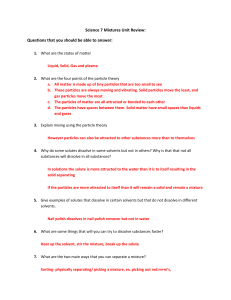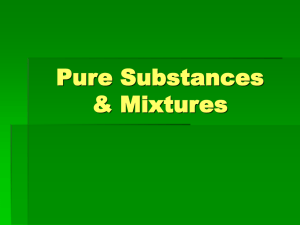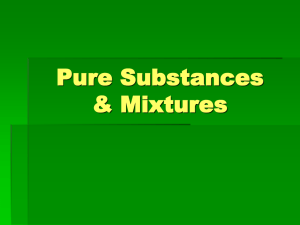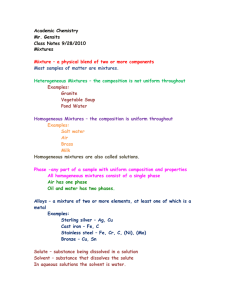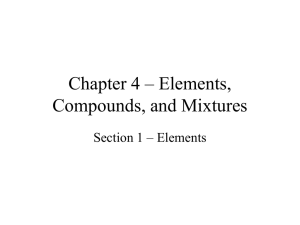Science 7Mixtures
advertisement
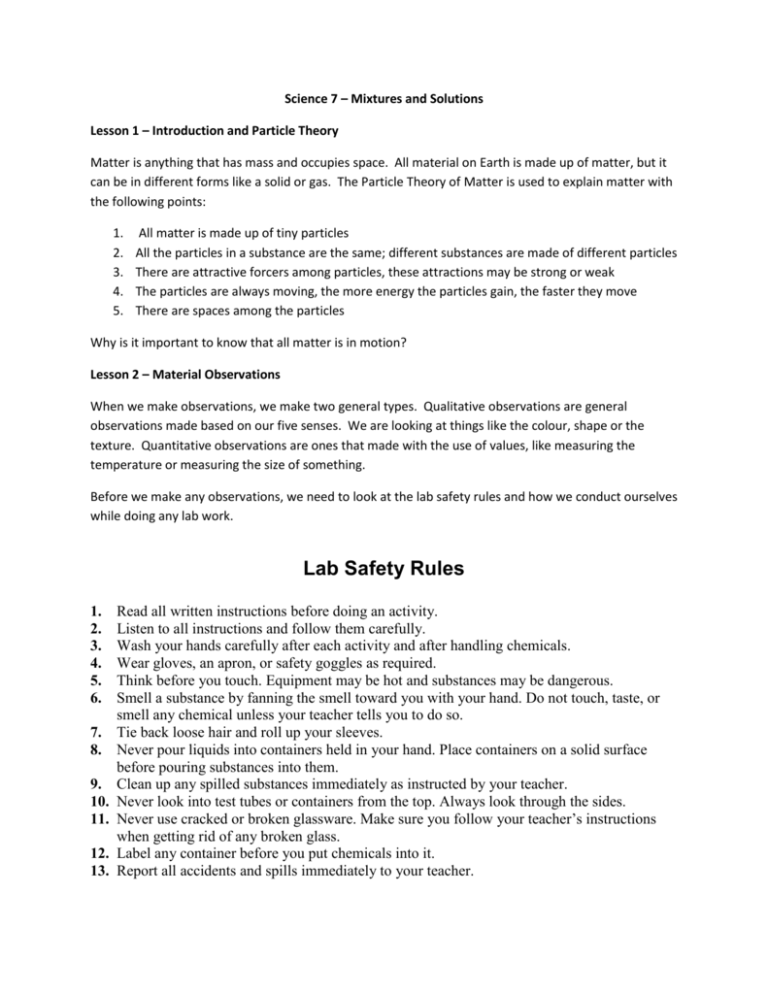
Science 7 – Mixtures and Solutions Lesson 1 – Introduction and Particle Theory Matter is anything that has mass and occupies space. All material on Earth is made up of matter, but it can be in different forms like a solid or gas. The Particle Theory of Matter is used to explain matter with the following points: 1. 2. 3. 4. 5. All matter is made up of tiny particles All the particles in a substance are the same; different substances are made of different particles There are attractive forcers among particles, these attractions may be strong or weak The particles are always moving, the more energy the particles gain, the faster they move There are spaces among the particles Why is it important to know that all matter is in motion? Lesson 2 – Material Observations When we make observations, we make two general types. Qualitative observations are general observations made based on our five senses. We are looking at things like the colour, shape or the texture. Quantitative observations are ones that made with the use of values, like measuring the temperature or measuring the size of something. Before we make any observations, we need to look at the lab safety rules and how we conduct ourselves while doing any lab work. Lab Safety Rules 1. 2. 3. 4. 5. 6. 7. 8. 9. 10. 11. 12. 13. Read all written instructions before doing an activity. Listen to all instructions and follow them carefully. Wash your hands carefully after each activity and after handling chemicals. Wear gloves, an apron, or safety goggles as required. Think before you touch. Equipment may be hot and substances may be dangerous. Smell a substance by fanning the smell toward you with your hand. Do not touch, taste, or smell any chemical unless your teacher tells you to do so. Tie back loose hair and roll up your sleeves. Never pour liquids into containers held in your hand. Place containers on a solid surface before pouring substances into them. Clean up any spilled substances immediately as instructed by your teacher. Never look into test tubes or containers from the top. Always look through the sides. Never use cracked or broken glassware. Make sure you follow your teacher’s instructions when getting rid of any broken glass. Label any container before you put chemicals into it. Report all accidents and spills immediately to your teacher. 14. If there are Workplace Hazardous Materials Information System (WHMIS) safety symbols on any chemical you will be using, make sure that you understand all the symbols. Always be sure to follow any directions as given by the instructor and absolutely no messing around while working in the lab! Please complete the What’s the Volume Observation Sheet to learn how to read the volume of a liquid and how to read the meniscus, and then complete the What’s the Mass Observation Sheet. (Line Master 2-8 and 2-9) Now, we will put these rules and you to the test while we make observations of the many different substances in the room. For each of the stations, be sure to list the name of the substance, followed by all of the quantitative and qualitative observations that you can make. Be sure to follow the station directions in each case. Lesson 3: The Three Phases of Matter There are three distinct phases of matter: Solid – particles are close, move very little definite shape and volume Liquid – particles have more space between, move around more, take the shape of the container giving no definite shape, but a definite volume Gas – Particles have more space in between, and move the most, spread through the entire container, no definite shape or volume Matter can go through changes of state and move from liquid to gas, for example. Changes of state are shown in the following graphic: Please write out the definitions of sublimation, vaporization, condensation, melting and freezing. Can we design a short, quick experiment to show all three phases of matter of water? Lesson 4 – Mixtures A few definitions to begin with: Mixture – Contains two or more substances Pure Substance – is one in which all the particles that make up the substance are the same Elements – Can not be broken down into simpler substances Compounds – contain two or more different elements in a fixed proportion The following is taken from the following link at Edquest: http://www.edquest.ca/component/content/article/169/ Classification of Matter - All pure substances have their own unique set of properties, or characteristics - All mixtures contain two or more pure substances, which have their own distinct properties (some of which may be hidden) Homogenous Mixtures (also called solutions) - are mixtures which look as though they have only one set of properties. - the blended mixture has equal amounts of both substances (all parts of the mixture are the same) - if the homogenous mixture does not have any settling of any of the substances it is made of, then it is called a solution - solutions occur because each particle slips between each other particle and is evenly distributed throughout the entire mixture Heterogeneous Mixtures (also called mechanical) - the properties of the pure substances, in a heterogeneous mixture, are not hidden - if there are two or more materials that are visible within a mixture, then it is called a heterogeneous mixture In-Between Mixtures - a heterogeneous mixture, in which the particles settle slowly after mixing, is called a suspension (eg. orange juice) - a heterogeneous mixture, in which the particles do not settle at all, is called a colloid (eg. fog) - to disperse the particles for a longer period of time, an emulsifying agent (like a protein) is used to form an emulsion (eg. mayonnaise) - mixtures that are obviously two or more substances are called mechanical mixtures the separate parts of the mechanical mixture are called phases Please complete the Which is Which: Pure Substance or Mixture? (Line Master 2-10) MIXING and DISSOLVING What Makes Materials Dissolve? - forming a solution by mixing two or more materials together is called dissolving - dissolving occurs because of the attracting between the particles (there may be a stronger attraction to the particles of another substance, than to the particles of the same substance) Solutes and Solvents The solute is the substance that dissolves in a solvent. The solvent is the substance that dissolves the solute to form a solution. Soluble means to be able to be dissolved in a particular solvent. Solutes and solvents can be gases or liquids. Water - the Universal Solvent - it is called the 'universal solvent' because it can dissolve so many materials - 97% of the water on Earth is Ocean water, 2% is frozen and only about 0.5% is 'usable' (and even this has materials already dissolved in it that can be harmful The Rate of Dissolving - the speed at which the solute dissolves in a solvent is called the rate of dissolving and can be affected by: - agitation (stirring or shaking) - temperature - pressure How Much Can Be Dissolved? - the limit to concentration is called solubility - a saturated solution is one in which no more solute will dissolve in a specific amount of solvent at a specific temperature - an unsaturated solution is one in which more solute can be dissolved in a specific solvent at the same specific temperature - solubility chart - using the particle theory, the attractive forces between the particles becomes balanced and no more particles of the solute can be attracted by the particles of the solvent Beyond the Limit: Supersaturated Solutions - a solution that contains more solute than would normally dissolve at a certain temperature is called a super-saturated solution. Cleaning Up with Solvents - Not all solute will dissolve in solvents. Insoluble means not able to be dissolved in a particular solvent. - certain solvents are used for special circumstances because they will dissolve some solutes that water and other solvents cannot (rubbing alcohol is use to dissolve chlorophyll - grass stains, because the particles have strong attractions) Please complete the Messing with Mixtures Lab. Lesson 5: Creating Solutions and Solubility Solute – The substance that does gets dissolved Solvent – The substance that does the dissolving Soluble – The ability to dissolve, high solubility means that it will dissolve easily Insoluble – Something that does not dissolve in the solvent So how does something dissolved anyway? How do your ice tea crystals dissolve in the water to make the drink? Let us go back to the particle theory and try to create an answer. When we create solutions the concentration can be shown in many different ways. When I make ice tea at home , the concentration is ½ cup ice tea mix per 1.25 litres of water. Often we use either grams/litres, or grams/100 ml. Meaning, if you had 3 litres of water and dropped in 100 g of sugar, your ratio would be: 100 g 1 litre There are 1000 ml in 1 litre, so this could also be written as: 100 g 1000ml How would we change 1000 ml into 100ml? What could we divide by? 100g divide by 10 10g 1000ml divide by 10 100ml Please complete More Tasty Solutions. (Line Master 2-17). Please complete creating solutions lab. (Line Master 2-18). Please complete Experiments on Temperature. Lesson 6 – Separating Mechanical Mixtures and Solutions We need to be able to separate solutions and mechanical mixtures so that we can break substances apart into their parts. Consider a water treatment plant that takes the waste water that you have used and through both mechanical separation (filters, holding tanks, etc.) and chemical separation to split the water and return usable, clean water to the environment. Think about a combine that mechanically separates the grain from the other parts of the plant. There are many other examples that can be considered: Separating Mixtures - when fluids are used to make solids flow, the solids must later be recovered - separation methods are designed to take advantage of the unique properties of the substances that have been mixed Desalinating Water - the ‘ 'desert tent’ method' (much like distillation) is inexpensive, but slow, and only practical in areas which receive a lot of bright sunlight - desalination plants, along the Red Sea, use lots of energy and are very expensive to operate - the process of removing water from a solution is called dehydration - the solvent (which is the water, in most cases) is separated from the solution by means of evaporation - distillation is a separation method that allows all the liquid fractions of a mixture to be separated from each other and collected independently - all seawater contains salt, but in varying amounts - from place to place, with the dead sea having the highest concentration Solid Mixtures From Underground - an ore is a mineral (or group of minerals) that contains a valuable substance (like gold) - to extract the substance (gold) that needs to be recovered it must be mined and crushed, then mixed with water to create a fine suspension - chemicals are then added to dissolve only the substance (gold) you want - the substance (gold) is then released from the solution when another substance (zinc) is added, allowing the residue (gold) to sink and be collected Project – Filtration and Separation – Separate a solution


